AirPollution
Air Pollution
Sources of Pollution
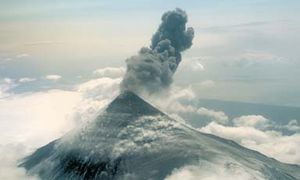
Generally, air pollution is any substance that people introduce into the atmosphere that has damaging effects on living things and the environment[2].
Both human activities and natural processes can create air pollution.
Human-related air pollution
- industrial waste gas composed of smoke, sulfides, nitrides, organic compounds, halides, carbides, etc.
- vehicle exhaust composed of carbon monoxide, sulfur dioxide, nitric oxides, and hydrocarbon as a result of burning fuels
- other pollutants created in human’s daily life, such as CFCs, ozone, and so on.
Natural Processes
- Volcanic activity releases pollutants, including, carbon dioxide, sulfuric oxides, and macro-particles into the atmosphere.
- Wildfires, desertification and emission of methane by animals are also major sources of the pollution.
Impacts of Pollution
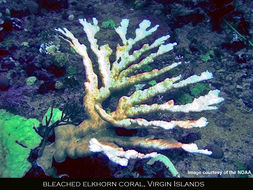
How will the air pollution effect the coral reefs in the ocean?
- The fine airborne particles, or aerosols, can scatter incoming sunlight and create cloudier, more reflective conditions[4]. These macro-particles floating in the air can reduce the amount of sunlight reaching the sea surface in a large scale. And if the amount of aerosols is too large, the haze may form and block even more sunlight. As a result, the photosynthesis of the single-celled algae, zooxanthellae, which keeps a symbiotic relation with coral, will reduce sharply. Thus, the amount of nutrition the coral can obtain from zooxanthellae in order for its growth will reduce. As less sunlight reaches the sea, the water temperature will fall, worsening the situation even more. The growth rate of coral will be limited due to the insufficient sunlight and the cold water temperature. Coral bleaching, a process caused by the expulsion of zooxanthellae, will occur if the water gets too cold, possibly leaving the coral to death[5].
- Global warming is another big threat to coral reefs. The rapid buildup of greenhouse gases (GHGs) in the atmosphere during the past centuries has brought significant contribution to the climate change in the world. As the climate gets hotter, the rising water temperature of ocean will cause large scale of coral bleaching. Massive corals will die as a result of the change of climate. The increasingly frequent extreme weathers and disasters such as hurricanes and tropical storms due to the change of climate and rise of water temperature will bring direct physical damages to coral reefs. Rising sea level due to global warming will make the situation even worse[5].
- It is reported that, many serious coral diseases are also related to air pollution. Scientists have found that many pathogens will travel with the aerosols and spread over the world. One example is the African dust traveled with wind from deserts in Africa. Every year, several hundred million tons of African dusts are transported across the Atlantic to the Caribbean, Central and South America[6]. Pathogens like fungus Aspergillus sydowii, which causes the sea-fan diseases, and sphingomonas, which is the cause of white plague, can travel with the dusts and move to the other side of the earth, causing catastrophic problems to local corals[7].
- Air pollution is also responsible for ocean acidification. Ocean water normally contains carbonic acid because carbon dioxide in the atmosphere can be dissolved by the water. However, if the amount of carbon dioxide continues to increase, the chemistry of ocean water will be altered as the water contains more carbonic acid. As the water becomes more acidic, the amount of aragonite -- a mineral used by corals in reef building -- in the water will decrease and the ability of corals to build reefs by laying down their limestone skeletons will also be limited. Thus, the reversal of reef building will slow down and the loss of reef in the future may be a result[5].
African Dust
The Global Dust Cycle
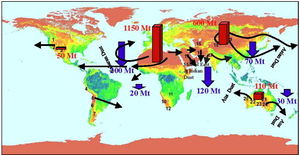
The global dust cycle is a geochemical process similar to the carbon or water cycle. Each year 2000 Mt of dust is emitted into the atmosphere from various regions around the world. Dust is swept off of deserts, carried across the globe and deposited in different locations (Figure 3). Dust affects soil formation in the rainforest, global climate, glacial cycles and the transport of micronutrients. This is a relatively new research topic and scientists continue to explore the many interactions of dust and the environment.
70% of the global dust cycle is the movement of dust from the Sahara region of Africa to the Caribbean ocean. In the 1970's scientists began to notice a correlation between dust movement and coral disease epidemics (Figure 4). This has led to increased research on the effect of African dust on Carribean reefs [9] .
Human Impacts
The transfer of African dust across the Atlantic Ocean is a natural phenomenon, but in the last 45 years, humans have altered the chemical and physical composition of dust to the point where dust now poses health risks for coral reef ecosystems and human populations. Human practices have increased the quantity of global dust and the chemical composition of dust.
- Increase in the quantity of dust-
Global temperature increases have left once fertile soil dry and sandy. This is especially true in the Sahara and Sahel regions of Africa. Further, human activity has played a significant role in the increase of dust that is carried across the Atlantic Ocean. Desertification and changing land-use patterns lead to further loss of habitable land, and ultimately to an increase in dust replacing topsoil.
- Change in Chemical Composition of Dust-
Human activities resulting from an agricultural-based economy have transformed dust into a toxic cloud. Dust now carries microbes, heavy metals and pesticides due to biomass combustion, the burning of fossil fuels, the improper disposal of plastics, and the use of pesticides in the source region [10].
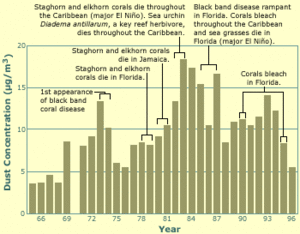
Causes and Effects
In the 1970's when a peak in dust pollution was observed in the Caribbean, the Sahel region of Africa was experiencing extreme drought conditions compounded by overgrazing and the drying of Lake Chad [10]. Other possible factors contributing to this episode include global climate change, changes in regional meteorology, and local human activities. Human activities such as burning fossil fuels, burning garbage, and spraying pesticides account for many of the toxins found in dust pollution[10]. Pesticides are a primary concern as they can interfere with animal reproduction, fertilization and immune function. Furthermore, two specific insecticides "chloropyrifos" and "endosulfan" are associated with preventing coral larvae to settle and reproduce[11]. The inorganic dust particulates are made of clay with gypsum and iron oxides that acts as a sponge to absorb other microorganisms. These particles can carry elements such as nitrogen and sulfur that can have harmful affects on surface waters, marine environments, and vegetation. In the Virgin Islands, vegetation has adapted to low nitrogen levels meaning that there could be serious impacts if an abundance of nitrogen is introduced. Sulfur and nitrogen also increase the acidity of water which could also lead to coral bleaching and death [12].
Effects of African Dust on Coral Reefs
Air samples collected in the Virgin Islands during "dust periods" have been found to contain 2-8 times as many organisms as air samples collected during not dust periods. This indicates that the dust is bringing with it harmful organisms that negatively impact coral [13].
For example, a fungus that exists in African spoil has been identified in the Virgin Islands and has caused a spike in Sea-Fan disease. Other coral diseases linked to African dust include:
- Black-band disease
- White plague
- White pox
- Bacterial included bleaching
- Pink spot disease
Effects of African Dust on Human Health
Dust has had a negative impact on the health of humans living in the surrounding Caribbean and Gulf regions. For example, Gene Shinn of the USGS says that asthma rates in the Caribbean are among the highest in the world. Specifically, asthma in Trinidad and Barbados has increased 17 times since the early 1970s. [10]
Asthma rates in Tampa Bay, Florida have seen a similar spike. Gene Shinn reports that close to half of the particles in the air breathed in the Tampa area originate from Africa.
Other human diseases linked to African dust include influenza, SARS, and tuberculosis.
Current Research
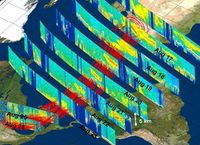
Dust samples are analyzed by measuring grain size, extracting organic compounds, using satellite imagery, pollen samples and microbe identification. Currently there are research stations in the U.S Virgin Islands, Cape Verde, Trinidad and Tobago and Mali. Aerosol samples are collected in Mali, tracked across the Atlantic Ocean using satellite imagery and wind patterns and analyzed again in the Caribbean.
Additional Educational Materials
Presentation
Lesson Plan
Media:African_Dust_Lesson_Plan_(2).pdf
References
- ↑ https://commons.wikimedia.org/wiki/File:Shishaldin_Volcano_eruption_1999.jpg
- ↑ "Air Pollution." National Geographic. N.p., n.d. Web. 13 Apr. 2014. Retrieved from http://environment.nationalgeographic.com/environment/global-warming/pollution-overview/
- ↑ "Coral Bleaching: Global Green House" Web. Apr. 2015. Retrieved from http://www.global-greenhouse-warming.com/coral-bleaching.html.
- ↑ Kwiatkowski, Lester. "Air Pollution Casts a Cloud over Coral Reef Growth." The Conversation. N.p., 8 Apr. 2013. Web. 16 Apr. 2014. Retrieved from http://theconversation.com/air-pollution-casts-a-cloud-over-coral-reef-growth-13319?utm_medium=email&utm_campaign=Latest+from+The+Conversation+for+9+April+2013&utm_content=Latest+from+The+Conversation+for+9+April+2013+CID_108dc635aa87df8ce801c5c3cc26a4cd&utm_source=campaign_monitor&utm_term=Air%20pollution%20casts%20a%20cloud%20over%20coral%20reef%20growth
- ↑ 5.0 5.1 5.2 Burke, Lauretta Marie., and Jonathan Maidens. Reefs at Risk in the Caribbean. Washington, D.C.: World Resources Institute, 2004. Print.
- ↑ "Asthma, Coral and African Dust." PBS. PBS, n.d. Web. 16 Apr. 2014. Retrieved from http://www.pbs.org/strangedays/episodes/onedegreefactor/experts/africandust.html
- ↑ Shinn, Eugene A., Garriet W. Smith, Joseph M. Prospero, Peter Betzer, Marshall L. Hayes, Virginia Garrison, and Richard T. Barber. "African Dust and the Demise of Caribbean Coral Reefs." Geophysical Research Letters 27.19 (2000): 3029. Print.
- ↑ 8.0 8.1 "Dust cycle: An emerging core theme in Earth system science " Web. Apr. 2016. Retrieved from http://dx.doi.org/10.1016/j.aeolia.2011.02.001.
- ↑ Yaping Shao, Karl-Heinz Wyrwoll " Dust cycle: An emerging core theme in Earth system science ." Aeolian Research, Volume 2, Issue 4, 2011, 181–204. Retrieved from http://dx.doi.org/10.1016/j.aeolia.2011.02.001.
- ↑ 10.0 10.1 10.2 10.3 10.4 "When the Dust Settles." May 2001. Web. <http://earthobservatory.nasa.gov/Features/Dust/>
- ↑ Handwerk, Brian. "Tainted African Dust Clouds Harm U.S., Caribbean Reefs." National Geographic News. 14 July 2008. Web. 23 Feb. 2015. Retrieved from http://news.nationalgeographic.com/news/2008/07/080714-africa-clouds.html.
- ↑ "Air Pollution Impacts: Virgin Islands National Park." National Park Service. 15 Jan. 2015. Web. 23 Feb. 2015. Retrieved from http://www.nature.nps.gov/air/Permits/aris/viis/impacts.cfm
- ↑ “The Effects of African Dust on Coral Reefs and Human Health.” USGS. April 2014. Web. <http://coastal.er.usgs.gov/african_dust/index.html>